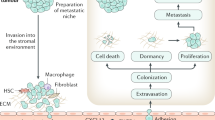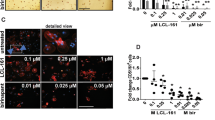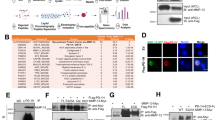Abstract
Multiple myeloma is characterized by extensive bone destruction with little or no new bone formation. A multiplicity of factors including receptor activator NF-κB (RANKL), macrophage inflammatory protein-1α, interleukin-3 and interleukin-6 can induce osteoclast formation in myeloma and drive the bone destructive process. Furthermore, factors are also produced either in the microenvironment or by myeloma cells themselves, which inhibit osteoblast differentiation and new bone formation. The combination of increased osteoclast formation with little or no bone repair in response to the previous bone destruction explains the severity of the bone disease in myeloma. Studies of the pathophysiology of myeloma bone disease have identified several novel therapeutic targets. These include antibodies to RANKL, chemokine receptor antagonists, which block the effects of chemokines on osteoclast differentiation and proteasome antagonists, which can affect both RANKL production and osteoprotegerin levels as well as inhibit osteoclast and enhance osteoblast differentiation. In addition, many of the new biologic agents being used for the treatment of patients with myeloma also further inhibit the bone destructive process. New therapies that can target both the tumor as well as the severe bone disease should be on the horizon to treat this devastating complication of myeloma.
This is a preview of subscription content, access via your institution
Access options
Subscribe to this journal
Receive 12 print issues and online access
$259.00 per year
only $21.58 per issue
Buy this article
- Purchase on Springer Link
- Instant access to full article PDF
Prices may be subject to local taxes which are calculated during checkout

Similar content being viewed by others
References
Roodman GD . Mechanisms of bone metastasis. New Engl J Med 2004; 350: 1655–1664.
Melton III LJ, Kyle RA, Achenbach SJ, Oberg AL, Rajkumar SV . Fracture risk with multiple myeloma: a population-based study. J Bone Miner Res 2005; 20: 487–493.
Diamond T, Levy S, Day P, Barbagallo S, Manoharan A, Kwan YK . Biochemical, histomorphometric and densitometric changes in patients with multiple myeloma: effects of glucocorticoid therapy and disease activity. Br J Haematol 1997; 97: 641–648.
Giuliani N, Rizzoli V, Roodman GD . Multiple myeloma bone disease: pathophysiology of osteoblast inhibition. Blood 2006; 108: 3992–3996.
Nilsson-Ehle H, Holmdahl C, Suurkula M, Westin J . Bone scintigraphy in the diagnosis of skeletal involvement and metastatic calcification in multiple myeloma. Acta Med Scand 1982; 211: 427–432.
Merico F, Bergui L, Gregoretti MG, Ghia P, Aimo G, Lindley IJ et al. Cytokines involved in the progression of multiple myeloma. Clin Exp Immunol 1993; 92: 27–31.
Hsu H, Lacey DL, Dunstan CR, Solovyev I, Colombero A, Timms E et al. Tumor necrosis factor receptor family member RANK mediates osteoclast differentiation and activation induced by osteoprotegerin ligand. Proc Natl Acad Sci USA 1999; 96: 3540–3545.
Nakagawa N, Kinosaki M, Yamaguchi K, Shima N, Yasuda H, Yano K et al. RANK is the essential signaling receptor for osteoclast differentiation factor in osteoclastogenesis. Biochem Biophys Res Commun 1998; 253: 395–400.
Boyle WJ, Simonet WS, Lacey DL . Osteoclast differentiation and activation. Nature 2003; 423: 337–342.
Lacey DL, Timms E, Tan HL, Kelley MJ, Dunstan CR, Burgess T et al. Osteoprotegerin ligand is a cytokine that regulates osteoclast differentiation and activation. Cell 1998; 93: 165–176.
Simonet WS, Lacey DL, Dunstan CR, Kelley M, Chang MS, Luthy R et al. Osteoprotegerin: a novel secreted protein involved in the regulation of bone density. Cell 1997; 89: 309–319.
Bucay N, Sarosi I, Dunstan CR, Morony S, Tarpley J, Capparelli C et al. Osteoprotegerin-deficient mice develop early onset osteoporosis and arterial calcification. Genes Dev 1998; 12: 1260–1268.
Dougall WC, Glaccum M, Charrier K, Rohrbach K, Brasel K, De Smedt T et al. RANK is essential for osteoclast and lymph node development. Genes Dev 1999; 13: 2412–2424.
Li J, Sarosi I, Yan XQ, Morony S, Capparelli C, Tan HL et al. RANK is the intrinsic hematopoietic cell surface receptor that controls osteoclastogenesis and regulation of bone mass and calcium metabolism. Proc Natl Acad Sci USA 2000; 97: 1566–1571.
Giuliani N, Colla S, Sala R, Moroni M, Lazzaretti M, La Monica S et al. Human myeloma cells stimulate the receptor activator of nuclear factor-kappa B ligand (RANKL) in T lymphocytes: a potential role in multiple myeloma bone disease. Blood 2002; 100: 4615–4621.
Farrugia AN, Atkins GJ, To LB, Pan B, Horvath N, Kostakis P et al. Receptor activator of nuclear factor-kappaB ligand expression by human myeloma cells mediates osteoclast formation in vitro and correlates with bone destruction in vivo. Cancer Res 2003; 63: 5438–5445.
Heider U, Langelotz C, Jakob C, Zavrski I, Fleissner C, Eucker J et al. Expression of receptor activator of nuclear factor kappaB ligand on bone marrow plasma cells correlates with osteolytic bone disease in patients with multiple myeloma. Clin Cancer Res 2003; 9: 1436–1440.
Lai FP, Cole-Sinclair M, Cheng WJ, Quinn JM, Gillespie MT, Sentry JW et al. Myeloma cells can directly contribute to the pool of RANKL in bone bypassing the classic stromal and osteoblast pathway of osteoclast stimulation. Br J Haematol 2004; 126: 192–201.
Sezer O, Heider U, Zavrski I, Kuhne CA, Hofbauer LC . RANK ligand and osteoprotegerin in myeloma bone disease. Blood 2003; 101: 2094–2098.
Pearse RN, Sordillo EM, Yaccoby S, Wong BR, Liau DF, Colman N et al. Multiple myeloma disrupts the TRANCE/ osteoprotegerin cytokine axis to trigger bone destruction and promote tumor progression. Proc Natl Acad Sci USA 2001; 98: 11581–11586.
Seidel C, Hjertner O, Abildgaard N, Heickendorff L, Hjorth M, Westin J et al. Serum osteoprotegerin levels are reduced in patients with multiple myeloma with lytic bone disease. Blood 2001; 98: 2269–2271.
Terpos E, Szydlo R, Apperley JF, Hatjiharissi E, Politou M, Meletis J et al. Soluble receptor activator of nuclear factor kappaB ligand-osteoprotegerin ratio predicts survival in multiple myeloma: proposal for a novel prognostic index. Blood 2003; 102: 1064–1069.
Yaccoby S, Pearse RN, Johnson CL, Barlogie B, Choi Y, Epstein J . Myeloma interacts with the bone marrow microenvironment to induce osteoclastogenesis and is dependent on osteoclast activity. Br J Haematol 2002; 116: 278–290.
Croucher PI, Shipman CM, Lippitt J, Perry M, Asosingh K, Hijzen A et al. Osteoprotegerin inhibits the development of osteolytic bone disease in multiple myeloma. Blood 2001; 98: 3534–3540.
Abe M, Hiura K, Wilde J, Shioyasono A, Moriyama K, Hashimoto T et al. Osteoclasts enhance myeloma cell growth and survival via cell-cell contact: a vicious cycle between bone destruction and myeloma expansion. Blood 2004; 104: 2484–2491.
Yaccoby S, Wezeman MJ, Henderson A, Cottler-Fox M, Yi Q, Barlogie B et al. Cancer and the microenvironment: myeloma-osteoclast interactions as a model. Cancer Res 2004; 64: 2016–2023.
Choi SJ, Cruz JC, Craig F, Chung H, Devlin RD, Roodman GD et al. Macrophage inflammatory protein 1-alpha (MIP-1α) is a potential osteoclast stimulatory factor in multiple myeloma. Blood 2000; 96: 671–675.
Okada Y, Tsukada J, Nakano K, Tonai S, Mine S, Tanaka Y . Macrophage inflammatory protein-1alpha induces hypercalcemia in adult T-cell leukemia. J Bone Miner Res 2004; 19: 1105–1111.
Hashimoto T, Abe M, Oshima T, Shibata H, Ozaki S, Inoue D et al. Ability of myeloma cells to secrete macrophage inflammatory protein (MIP)-1alpha and MIP-1beta correlates with lytic bone lesions in patients with multiple myeloma. Br J Haematol 2004; 125: 38–41.
Magrangeas F, Nasser V, Avet-Loiseau H, Loriod B, Decaux O, Granjeaud S et al. Gene expression profiling of multiple myeloma reveals molecular portraits in relation to the pathogenesis of the disease. Blood 2003; 101: 4998–5006.
Oyajobi BO, Franchin G, Williams PJ, Pulkrabek D, Gupta A, Munoz S et al. Dual effects of macrophage inflammatory protein-1alpha on osteolysis and tumor burden in the murine 5TGM1 model of myeloma bone disease. Blood 2003; 102: 311–319.
Oyajobi BO, Mundy GR . Receptor activator of NF-kappaB ligand, macrophage inflammatory protein-1alpha, and the proteasome: novel therapeutic targets in myeloma. Cancer 2003; 97: 813–817.
Masih-Khan E, Trudel S, Heise C, Li Z, Paterson J, Nadeem V et al. MIP-1alpha (CCL3) is a downstream target of FGFR3 and RAS-MAPK signaling in multiple myeloma. Blood 2006; 108: 3465–3471.
Lee JW, Chung HY, Ehrlich LA, Jelinek DF, Callander NS, Roodman GD et al. IL-3 expression by myeloma cells increases both osteoclast formation and growth of myeloma cells. Blood 2004; 103: 2308–2315.
Kurihara N, Bertolini D, Suda T, Akiyama Y, Roodman GD . IL-6 stimulates osteoclast-like multinucleated cell formation in long-term human marrow cultures by inducing IL-1 release. J Immunol 1990; 144: 4226–4230.
Sati HI, Apperley JF, Greaves M, Lawry J, Gooding R, Russell RG et al. Interleukin-6 is expressed by plasma cells from patients with multiple myeloma and monoclonal gammopathy of undetermined significance. Br J Haematol 1998; 101: 287–295.
Abildgaard N, Glerup H, Rungby J, Bendix-Hansen K, Kassem M, Brixen K et al. Biochemical markers of bone metabolism reflect osteoclastic and osteoblastic activity in multiple myeloma. Eur J Haematol 2000; 64: 121–129.
Rossi JF, Fegueux N, Lu ZY, Legouffe E, Exbrayat C, Bozonnat MC et al. Optimizing the use of anti-interleukin-6 monoclonal antibody with dexamethasone and 140 mg/m2 of melphalan in multiple myeloma: results of a pilot study including biological aspects. Bone Marrow Transplant 2005; 36: 771–779.
Nguyen AN, Stebbins EG, Henson M, O'Young G, Choi SJ, Quon D et al. Normalizing the bone marrow microenvironment with p38 inhibitor reduces multiple myeloma cell proliferation and adhesion and suppresses osteoclast formation. Exp Cell Res 2006; 312: 1909–1923.
Vanderkerken K, Medicherla S, Coulton L, Van Camp B, Protter A, Higgins L et al. Inhibition of p38α MAPK reduces tumor burden, prevents the development of myeloma bone disease, and increases survival in the 5T2 and 5T33 murine models of myeloma. Blood 2006; 108: 981a (abstr. 3436).
Kurihara N, Hiruma Y, Windle J, Hong CS, Shin J, Roodman D . Targeting p62 in marrow stromal cells is effective at inhibiting myeloma cell growth. Blood 2006; 108: 155a (abstr. 513).
Taube T, Beneton MN, McCloskey EV, Rogers S, Greaves M, Kanis JA . Abnormal bone remodeling in patients with myelomatosis and normal biochemical indices of bone resorption. Eur J Haematol 1992; 49: 192–198.
Yaccoby S, Wezeman MJ, Zangari M, Walker R, Cottler-Fox M, Gaddy D et al. Inhibitory effects of osteoblasts and increased bone formation on myeloma in novel culture systems and a myelomatous mouse model. Haematologica 2006; 91: 192–199.
Ehrlich LA, Chung HY, Ghobrial I, Choi SJ, Morandi F, Colla S et al. IL-3 is a potential inhibitor of osteoblast differentiation in multiple myeloma. Blood 2005; 106: 1407–1414.
Giuliani N, Colla S, Morandi F, Lazzaretti M, Sala R, Bonomini S et al. Myeloma cells block RUNX2/CBFA1 activity in human bone marrow osteoblast progenitors and inhibit osteoblast formation and differentiation. Blood 2005; 106: 2472–2483.
Oshima T, Abe M, Asano J, Hara T, Kitazoe K, Sekimoto E et al. Myeloma cells suppress bone formation by secreting a soluble Wnt inhibitor, sFRP-2. Blood 2005; 106: 3160–3165.
Tian E, Zhan F, Walker R, Rasmussen E, Ma Y, Barlogie B et al. The role of the Wnt-signaling antagonist DKK1 in the development of osteolytic lesions in multiple myeloma. N Engl J Med 2003; 349: 2483–2494.
Giuliani N, Morandi F, Tagliaferri S, Agnelli L, Todoerti K, Pedrazzoni M et al. DKK-1 and sFRP-3 expression by myeloma cell and bone marrow plasma levels in multiple myeloma and MGUS patients: potential relationship with bone status. Blood 2006; 108: 981a (abstr. 3437).
Yaccoby S, Ling W, Zhan F, Walker R, Barlogie B, Shaughnessy Jr JD . Antibody-based inhibition of DKK1 suppresses tumor-induced bone resorption and multiple myeloma growth in-vivo. Blood 2007; 109: 2106–2111.
Lee SK, Kalinowski JF, Jacquin C, Adams DJ, Gronowicz G, Lorenzo JA . Interleukin-7 influences osteoclast function in vivo but is not a critical factor in ovariectomy-induced bone loss. J Bone Miner Res 2006; 21: 695–702.
Toraldo G, Roggia C, Qian WP, Pacifici R, Weitzmann MN . IL-7 induces bone loss in vivo by induction of receptor activator of nuclear factor kappa B ligand and tumor necrosis factor alpha from T cells. Proc Natl Acad Sci USA 2003; 100: 125–130.
Berenson JR, Lichtenstein A, Porter L, Dimopoulos MA, Bordoni R, George S et al. Efficacy of pamidronate in reducing skeletal events in patients with advanced multiple myeloma. Myeloma Aredia Study Group. N Engl J Med 1996; 334: 488–493.
Coleman RE, Major P, Lipton A, Brown JE, Lee KA, Smith M et al. Predictive value of bone resorption and formation markers in cancer patients with bone metastases receiving the bisphosphonate zoledronic acid. J Clin Oncol 2005; 23: 4925–4935.
Berenson JR, Rosen LS, Howell A, Porter L, Coleman RE, Morley W et al. Zoledronic acid reduces skeletal-related events in patients with osteolytic metastases. Cancer 2001; 91: 1191–1200.
Aguiar Bujanda D, Bohn Sarmiento U, Cabrera Suarez MA, Aguiar Morales J . Assessment of renal toxicity and osteonecrosis of the jaws in patients receiving zoledronic acid for bone metastasis. Ann Oncol 2007; 18: 556.
Lacy MQ, Dispenzieri A, Gertz MA, Greipp PR, Gollbach KL, Hayman SR et al. Mayo clinic consensus statement for the use of bisphosphonates in multiple myeloma. Mayo Clin Proc 2006; 81: 1047–1053.
Body JJ, Facon T, Coleman RE, Lipton A, Geurs F, Fan M et al. A study of the biological receptor activator of nuclear factor-kappaB ligand inhibitor, denosumab, in patients with multiple myeloma or bone metastases from breast cancer. Clin Cancer Res 2006; 12: 1221–1228.
Body JJ, Greipp P, Coleman RE, Facon T, Geurs F, Fermand JP et al. AMGN-0007, a recombinant osteoprotegerin construct, in patients with multiple myeloma or breast carcinoma related bone metastases. Cancer 2003; 97: 887–892.
Mbalaviele G, Anderson G, Jones A, De Ciechi P, Settle S, Mnich S et al. Inhibition of p38 mitogen-activated protein kinase prevents inflammatory bone destruction. J Pharmacol Exp Ther 2006; 317: 1044–1053.
Rossa C, Ehmann K, Liu M, Patil C, Kirkwood KL . MKK3/6-p38 MAPK signaling is required for IL-1beta and TNF-alpha-induced RANKL expression in bone marrow stromal cells. J Interferon Cytokine Res 2006; 26: 719–729.
Zangari M, Yaccoby S, Cavallo F, Esseltine D, Tricot G . Response to bortezomib and activation of osteoblasts in multiple myeloma. Clin Lymphoma Myeloma 2006; 7: 109–114.
Heider U, Kaiser M, Muller C, Jakob C, Zavrski I, Schulz CO et al. Bortezomib increases osteoblast activity in myeloma patients irrespective of response to treatment. Eur J Haematol 2006; 77: 233–238.
Garrett IR, Chen D, Gutierrez G, Zhao M, Escobedo A, Rossini G et al. Selective inhibitors of the osteoblast proteasome stimulate bone formation in vivo and in vitro. J Clin Invest 2003; 111: 1771–1782.
Terpos E, Heath D, Rahemtulla A, Zervas K, Chantry A, Anagnostopoulos A et al. Bortezomib reduces serum dickkopf-1 and RANKL concentrations and normalizes indices of bone remodeling in patients with relapsed multiple myeloma. Blood 2006; 108: 153a (abstr. 506).
Giuliani N, Morandi F, Tagliaferri S, Lazzaretti M, Bonomini S, Crugnola M et al. The proteasome inhibitor bortezomib affects osteoblastogenesis and bone formation in vitro and in vivo in multiple myeloma patients. Blood 2006; 108: 154a (abstr. 508).
Oba Y, Lee JW, Ehrlich LA, Chung HY, Jelinek DF, Callander NS et al. MIP-1alpha utilizes both CCR1 and CCR5 to induce osteoclast formation and increase adhesion of myeloma cells to marrow stromal cells. Exp Hematol 2005; 33: 272–278.
Lentzsch S, Gries M, Janz M, Bargou R, Dorken B, Mapara MY . Macrophage inflammatory protein 1-alpha (MIP-1 alpha) triggers migration and signaling cascades mediating survival and proliferation in multiple myeloma (MM) cells. Blood 2003; 101: 3568–3573.
Pennisi A, Ling W, Perkins P, Saha R, Li X, Barlogie B et al. PTH and bortezomib suppress growth of primary human myeloma through increased bone formation in vivo. Blood 2006; 108: 154a (abstr. 509).
Feng R, Anderson G, Xiao G, Elliott G, Leoni L, Mapara MY et al. SDX-308, a non-steroidal anti-inflammatory agent, inhibits NF-{kappa}B activity resulting in strong inhibition of osteoclast formation/activity and multiple myeloma cell growth. Blood 2007; 109: 2130–2138.
Anderson G, Gries M, Kurihara N, Honjo T, Anderson J, Donnenberg V et al. Thalidomide derivative CC-4047 inhibits osteoclast formation by down-regulation of PU.1. Blood 2006; 107: 3098–3105.
Author information
Authors and Affiliations
Corresponding author
Rights and permissions
About this article
Cite this article
Roodman, G. Treatment strategies for bone disease. Bone Marrow Transplant 40, 1139–1146 (2007). https://doi.org/10.1038/sj.bmt.1705802
Received:
Revised:
Accepted:
Published:
Issue Date:
DOI: https://doi.org/10.1038/sj.bmt.1705802
Keywords
This article is cited by
-
Identification of a binding site on soluble RANKL that can be targeted to inhibit soluble RANK-RANKL interactions and treat osteoporosis
Nature Communications (2022)
-
Vitamin D-mediated hypercalcemia in multicentric Castleman’s disease
Journal of Bone and Mineral Metabolism (2017)
-
Dissecting the multiple myeloma-bone microenvironment reveals new therapeutic opportunities
Journal of Molecular Medicine (2016)
-
Constitutive activation of p38 MAPK in tumor cells contributes to osteolytic bone lesions in multiple myeloma
Leukemia (2012)
-
Pathogenesis of myeloma bone disease
Leukemia (2009)



